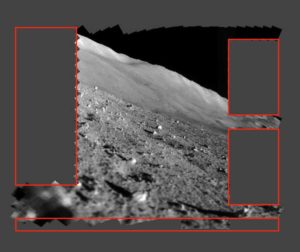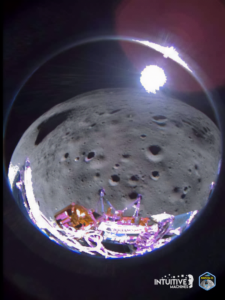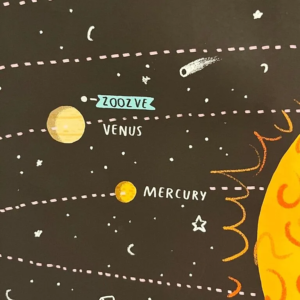This year is obviously warming up at last, because no less than seven small coolish ph-items popped up in February.
Couple of them came from deep space: A quasar 12 billion light years away is the brightest object ever discovered; and we got a glimpse of what was left behind by the supernova of 1987 (a neutron star).
One came from the lab; it’s small but could turn out to start a large avalanche: People did lab measurements of gravity between objects at extremely small scales, opening a possible road for joint quantum and gravitational measurements.
But most news came from the solar system. Seas were -indirectly- found under the surface of Saturn’s moon Mimas. Two spacecraft are currently found on our own Moon, and both of them are slanted; the Odysseus lander arrived just now and SLIM, which we covered last month, surprisingly woke up after considered gone. And, in quasi-news, we had one of the cutest namings of celestial bodies, when a quasi-moon of Venus’ got to be named Zoozve.
Read on for the non-tldr version. You might worry it’ll be long. But fear not, for I’ve got you covered: I asked Chat to rewrite everything in Harry Potter style. It had a field day.
🌒
In the bustling corridors of the universe, where stars twinkle like enchanted jewels and galaxies swirl in an eternal dance, whispers of extraordinary discoveries echo through the cosmic tapestry. Let us embark on a journey through the enchanted realms of astrophysics [Chapette: and quantum gravity], where wonders abound and mysteries unravel like spells cast by a wizard’s wand.
🌓
Amidst the vast expanse of the cosmos, a celestial spectacle unlike any other graces the stage of the heavens. Behold, the discovery of the brightest object ever to grace the universe—a quasar, ablaze with the fiery radiance of a thousand [Ch.: 500 trillion] suns! Powered by the swiftest-growing black hole ever beheld, this cosmic titan devours the essence of stars with insatiable hunger, consuming the equivalent of a sun each passing day. Its brilliance, a mesmerizing beacon amidst the cosmic darkness, outshines even the mightiest stars, bathing the cosmos in its luminous glow. Nestled twelve billion light-years away, this wondrous spectacle was first unveiled by the keen eyes of Australian National University scientists, who beheld its glory through the lenses of their celestial observatory.
🌔
In the annals of celestial history, the year 1987 witnessed a cataclysmic event of cosmic proportions—a supernova, an explosion so grand and majestic that it captivated the gaze of astronomers across the cosmos. Now, through the arcane gaze of the James Webb Space Telescope, the veil of mystery surrounding this stellar enigma begins to part. Within the remnants of its celestial inferno, whispers of a neutron star emerge, shrouded in the remnants of its cosmic dance—a testament to the eternal ballet of creation and destruction that defines the cosmos.
🌕
In the hallowed halls of scientific inquiry, a fellowship of minds from across the realms of UK, Netherlands, and Italy has achieved a feat of unparalleled ingenuity. Through the mystic arts of superconductivity and cryogenic enchantments, they have harnessed the very essence of gravity itself, measuring its ethereal touch upon the smallest of scales—a triumph that resonates with the echoes of quantum mysteries yet unraveled.
But why does this achievement spark such awe, even among the most arcane circles of academia? It marks the first instance in which humanity has ventured into the quantum realm to measure the elusive dance of gravity—a realm so infinitesimal and enigmatic that it defies the grasp of conventional physics.
And yet, this accomplishment holds even deeper significance, for it ventures into the heart of one of science’s most profound enigmas—the unification of quantum mechanics and gravity. Like two celestial bodies orbiting each other in a cosmic ballet, these two fundamental powers have long eluded the grasp of human understanding [Ch.: when trying to describe them together]. But with this breakthrough, a flicker of hope ignites—a beacon illuminating the path toward a future where the mysteries of the quantum realm and the pull of gravity may one day be woven into the same tapestry of scientific knowledge. Let us stand witness to this momentous journey and dare to dream of the boundless horizons it may unveil.
🌖
Beneath the icy shroud of Saturn’s moon, Mimas, lies a hidden world of liquid seas—a revelation that defies the expectations of celestial cartographers and hints at the mysteries that lie beneath the surface of distant worlds. Amidst the pantheon of celestial bodies, Mimas joins the ranks of Europa, Titan and Enceladus [Ch.: for underground oceans], as a testament to the boundless wonders of the cosmos.
🌗
From the shadowed depths of lunar slumber, a dormant explorer awakens—the JAXA’s SLIM, its journey interrupted by the whims of fate [Ch.: it tripped and landed on its side], now rises once more to gaze upon the lunar horizon, sending tidings of its reawakening to the distant realms of Earth.

🌘
In a tale of triumph and tribulation upon the lunar stage, the saga of mission IM-1 unfolds—its lander, Odysseus, commissioned by NASA and crafted by the hands of Intuitive Machines, graces the lunar surface with the mark of human ingenuity. Though beset by the trials of lunar terrain [Ch.: it tripped and landed on its side], its legacy as the first successful Moon landing by a private company shall endure as a testament to the indomitable spirit of exploration.

🌑
Amidst the celestial ballet of Venus and its entourage of celestial companions, a curious wanderer embarks upon an orbit of whimsy—the quasi-moon known as Zoozve.
What is a quasi-moon, you might wonder? It is a celestial vagabond, an asteroid that meanders through the heavens in a delicate dance with its planetary neighbor. Though it orbits the planet, it remains untethered by the bonds of gravity—a celestial nomad, destined one day to wander beyond the grasp of its planetary companion.
But what tale lies hidden within the name “Zoozve”? Cast your gaze back to the year 2002, where amidst the corridors of discovery, astronomer Brian Skiff of Lowell Observatory unveiled the first known quasi-moon orbiting Venus. Yet, this celestial marvel bore not the grandeur of a regal title, but instead was bestowed with the temporary moniker “2002VE68”.
In a twist of fate worthy of the most enchanting tales, a young apprentice of the cosmos [Ch.: a child] named Alex Foster, inspired by the wonders of the heavens, etched the name “2002VE” into the annals of discovery. But as fate would have it, the scribbles upon his celestial parchment would soon take flight upon the wings of whimsy. A misreading of his notes transformed “2002VE” into the enchanting enigma known as Zoozve.

And so, dear readers, let us revel in the enchanting saga of Zoozve—a celestial wanderer whose name echoes with the laughter of cosmic whimsy, reminding us that amidst the grandeur of the cosmos, the spark of curiosity and the magic of discovery shall forever illuminate our journey among the stars.
🌒
With each revelation and discovery, the tapestry of the cosmos weaves itself anew, beckoning forth the curious minds of wanderers and scholars alike to delve deeper into its infinite mysteries. So let us raise our wands, dear readers, and embark upon a journey through the enchanted realms of the ph-word, where magic and science intertwine in a cosmic dance of wonder and discovery.
—
In the echoes of the cosmic symphony, where stars sing their celestial melodies, a humble invitation beckons forth the curious and the bold. Would you, dear traveler, care to embark upon a monthly journey through the realms of Ph-word? Join us on this odyssey of discovery and wonder—a celestial voyage guided by the gentle touch of the stars. Simply lend us your hand, and together we shall traverse the cosmic expanse, unraveling the mysteries of the universe one Ph-word at a time. Would you care to join our fellowship? [Ch.: Join the mailing list.]
